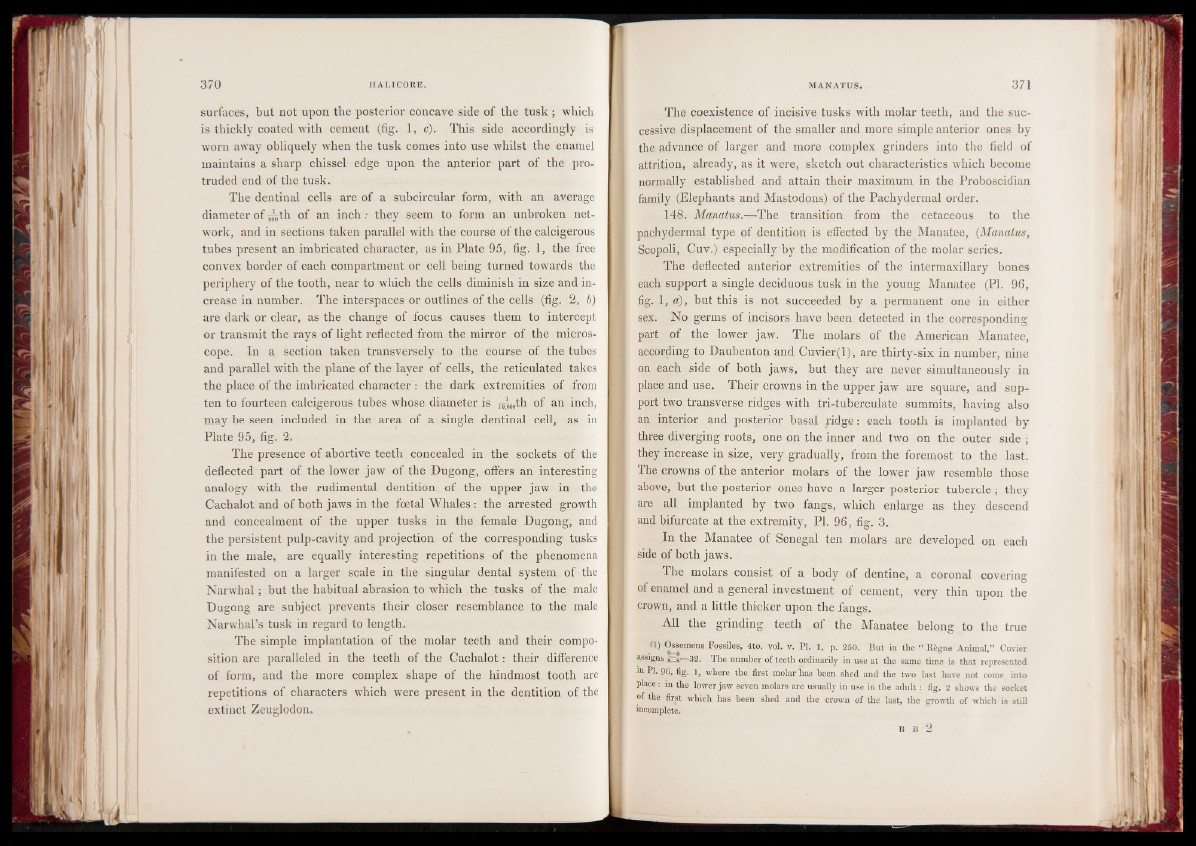
surfaces, but not upon the posterior concave side of the tusk ; which
is thickly coated with cement (fig. 1, c). This side accordingly is
worn away obliquely when the tusk comes into use whilst the enamel
maintains a sharp chissel edge upon the anterior part of the protruded
end of the tusk.
The dentinal cells are of a subcircular form, with an average
diameter of ^ th of an inch .• they seem to form an unbroken network,
and in sections taken parallel with the course of the calcigerous
tubes present an imbricated character, as in Plate 95, fig. 1, the free
convex border of each compartment or cell being turned towards the
periphery of the tooth, near to which the cells diminish in size and increase
in number. The interspaces or outlines of the cells (fig. 2, 6)
are dark or clear, as the change of focus causes them to intercept
or transmit the rays of light reflected from the mirror of the microscope.
In a section taken transversely to the course of the tubes
and parallel with the plane of the layer of cells, the reticulated takes
the place of the imbricated character : the dark extremities of from
ten to fourteen calcigerous tubes whose diameter is jp^th of an inch,
may be seen included in the area of a single dentinal cell, as in
Plate 95, fig. 2.
The presence of abortive teeth concealed in the sockets of the
deflected part of the lower jaw of the Dugong, offers an interesting
analogy with the rudimental dentition of the upper jaw in the
Cachalot and of both jaws in the foetal Whales : the arrested growth
and concealment of the upper tusks in the female Dugong, and
the persistent pulp-cavity and projection of the corresponding tusks
in the male, are equally interesting repetitions of the phenomena
manifested on a larger scale in the singular dental system of the
Narwhal ; but the habitual abrasion to which the tusks of the male
Dugong are subject prevents their closer resemblance to the male
Narwhal’s tusk in regard to length.
The simple implantation of the molar teeth and their composition
are paralleled in the teeth of the Cachalot : their difference
of form, and the more complex shape of the hindmost tooth are
repetitions of characters which were present in the dentition of the
extinct Zeuglodon.
The coexistence of incisive tusks with molar teeth, and the successive
displacement of the smaller and more simple anterior ones by
the advance of larger and more complex grinders into the field of
attrition, already, as it were, sketch out characteristics which become
normally established and attain their maximum in the Proboscidian
family (Elephants and Mastodons) of the Pachydermal order.
148. Manatus.—The transition from the cetaceous to the
pachydermal type of dentition is effected by the Manatee, (Manatus,
Scopoli, Cuv.) especially by the modification of the molar series.
The deflected anterior extremities of the intermaxillary bones
each support a single deciduous tusk in the young Manatee (PI. 96,
fig. 1, a), but this is not succeeded by a permanent one in either
sex. No germs of incisors have been detected in the corresponding
part of the lower jaw. The molars of the American Manatee,
according to Daubenton and Cuvier(l), are thirty-six in number, nine
on each side of both jaws, but they are never simultaneously in
place and use. Their crowns in the upper jaw are square, and support
two transverse ridges with tri-tuberculate summits, having also
an interior and posterior basal ridge: each tooth is implanted by
three diverging roots, one on the inner and two on the outer side;
they increase in size, very gradually, from the foremost to the last.
The crowns of the anterior molars of the lower jaw resemble those
above, but the posterior ones have a larger posterior tubercle ; they
are all implanted by two fangs, which enlarge as they descend
and bifurcate at the extremity, PI. 96, fig. 3.
In the Manatee of Senegal ten molars are developed on each
side of both jaws.
The molars consist of a body of dentine, a coronal covering
of enamel and a general investment of cement, very thin upon the
crown, and a little thicker upon the fangs.
All the grinding teeth of the Manatee belong to the true
(1) Ossemens Fossiles, 4to. vol. v. PI. 1, p. 250. But in the “ Règne Animal,” Cuvier
assigns 8—8 32* The number of teeth ordinarily in use at the same time is that represented
ln 96> fig- 1» where the first molar has been shed and the two last have not come into
place : in the lower jaw seven molars are usually in use in the adult : fig. 2 shows the socket
of the first which has been shed and the crown of the last, the growth of which is still
incomplete.